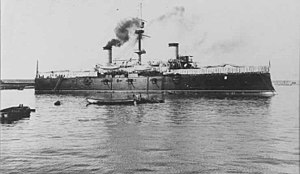Spanish cruiser Cristóbal Colón

Cristóbal Colón in 1897–1898
|
|
| History | |
|---|---|
|
|
|
| Name: | Giuseppe Garibaldi |
| Namesake: | Giuseppe Garibaldi |
| Builder: | Italy |
| Laid down: | 1895 |
| Launched: | September 1896 |
| Fate: | Sold to Spain, 16 May 1897 |
|
|
|
| Name: | Cristóbal Colón |
| Namesake: | Christopher Columbus |
| Completed: | May 1897 |
| Acquired: | 16 May 1897 |
| Fate: | Sunk 3 July 1898 |
| General characteristics | |
| Class and type: | Giuseppe Garibaldi-class armored cruiser |
| Displacement: | 7,972 long tons (8,100 t) full load |
| Length: | 366 ft 8 in (111.76 m) |
| Beam: | 59 ft 10 1⁄2 in (18.250 m) |
| Draft: | 23 ft 3 1⁄2 in (7.099 m) maximum |
| Installed power: | 13,655–14,713 ihp (10.183–10.971 MW) |
| Propulsion: | Vertical triple expansion, 24 boilers |
| Speed: | 19.3–20.02 knots (35.74–37.08 km/h) |
| Range: | 4,400 nmi (8,100 km) at 10 kn (19 km/h) |
| Endurance: | 1,050 long tons (1,070 t) coal (normal) |
| Complement: | 510 to 559 officers and enlisted |
| Armament: |
|
| Armor: |
|
Cristóbal Colón was a Giuseppe Garibaldi-class armored cruiser of the Spanish Navy that fought at the Battle of Santiago de Cuba during the Spanish–American War.
Cristóbal Colón was built in Italy under the name Giuseppe Garibaldi. She was laid down in 1895, launched in September 1896, sold to Spain, and delivered to the Spanish Navy at Genoa on 16 May 1897. She had two funnels and was fast, well armed, and well protected, especially for her displacement. She was designed to be an intermediate type of ship between extant battleships and cruisers, powerful enough to function as a part of a battle fleet and yet fast enough to outrun more powerful ships, and in this sense was the Spanish Navy's first true armored cruiser. However, the Spanish Ministry of Marine rejected her 10-inch (250 mm) gun, and she was delivered without it, detracting considerably from her designed firepower; she was lost before the gun could be installed.
Cristóbal Colón was part of the Spanish Navy's 1st Squadron when tensions with the United States were rising after the explosion and sinking of the battleship USS Maine in the harbor at Havana, Cuba on 15 February 1898. The squadron concentrated at São Vicente in Portugal's Cape Verde Islands; departing Cadiz on 8 April. The Spanish–American War began while Cristóbal Colón was at São Vicente. Ordered by neutral Portugal in accordance with international law to leave São Vicente within 24 hours of the declaration of war, Cristóbal Colón and the rest of Cervera's squadron departed on 29 April 1898, bound for San Juan, Puerto Rico. Cervera's ships reached French-owned Martinique in the Lesser Antilles on 10 May 1898. While Cristóbal Colón and the other large ships loitered in international waters, two Spanish destroyers went into Fort-de-France to ask for coal. France was neutral and would not supply coal, so the Spanish squadron departed on 12 May 1898 for Dutch-owned Curaçao, where Cervera expected to meet a collier. Cervera arrived at Willemstad on 14 May 1898, but the Netherlands was also neutral, and strictly enforced its neutrality by allowing only Infanta Maria Teresa and her sister ship Vizcaya to enter port and permitting them to load only 600 long tons (610 t) of coal. On 15 May, Cervera's ships departed, no longer bound for San Juan, which by now was under a U.S. Navy blockade, but for as-yet unblockaded Santiago de Cuba on the southeastern coast of Cuba, arriving there on 19 May 1898. Cervera hoped to refit his ships there before he could be trapped. His squadron was still in the harbor of Santiago de Cuba when an American squadron arrived on 27 May 1898 and began a blockade which would drag on for 37 days.
...
Wikipedia
